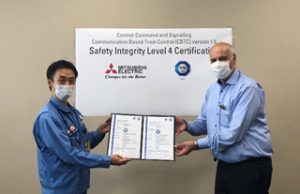 Mitsubishi Electric Corporation obtained the SIL4 certification from TÜV SÜD for the upgraded CBTC system version 1.5, following the safety assessment.
Mitsubishi Electric Corporation obtained the SIL4 certification from TÜV SÜD for the upgraded CBTC system version 1.5, following the safety assessment.
Mitsubishi Electric upgraded their CBTC system version 1.0, certified by TÜV SÜD in 2014, by introducing improved design and additional functionality to result in the CBTC system version 1.5. TÜV SÜD has issued two SIL4 certificates for the WZC (Wayside Zone Controller) and OBC (On Board Controller) subsystems.
“TÜV SÜD Rail successfully completed the Independent Safety Assessment and Certification of the upgrade of the Mitsubishi CBTC system. Key success factors were the frequent direct communication with Mitsubishi Electric Corporation and the excellent collaboration with our staff on-site at TÜV SÜD Japan,” Christian Fischer, Senior Safety Assessor Signalling at TÜV SÜD Rail Germany said.
The Safety Integrity Level (SIL) defines the level of safety required by the international standards EN 50126, EN 50128 and EN 50129. The standards distinguish between four safety integrity levels with SIL4 representing the highest level of safety.
“We are glad that we were able to contribute to this SIL4 certification, which grants access to the global market,” Jürgen Apitzsch, Technical Manager at TÜV SÜD Rail Japan, said.
The wireless train control systems known as Communication Based Train Control (CBTC) are beginning to conquer the Japanese market as next generation signalling systems. CBTCs consist of a trackside subsystem, Wayside Zone Controller (WZC) and an onboard subsystem – On Board Controller (OBC). Both units communicate via radio to control the train run and ensure the safe separation of trains in the “moving-block” distance. This allows trains to run at shorter intervals and thus increases track capacity. CBTC railway signalling systems must fulfil a high level of safety and reliability, for which TÜV SÜD grants SIL4 certification and also provides associated rail-related services including safety assessment, certification and training services.
Share on:



